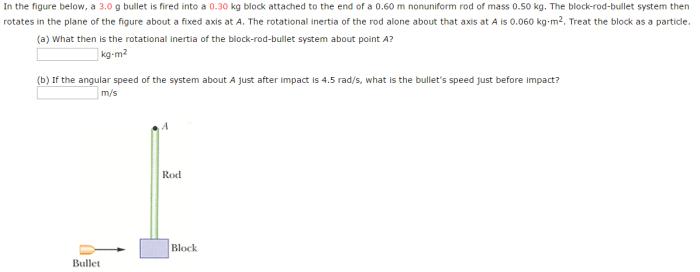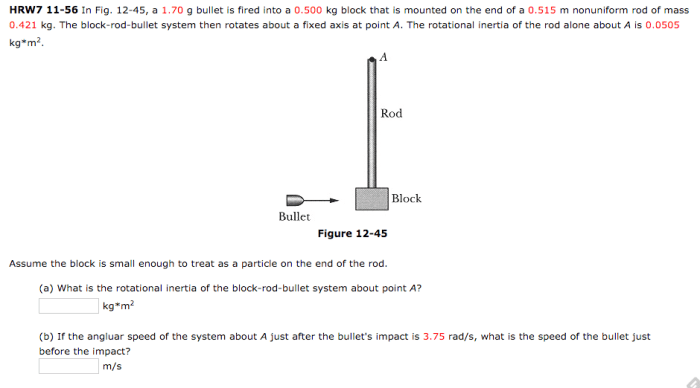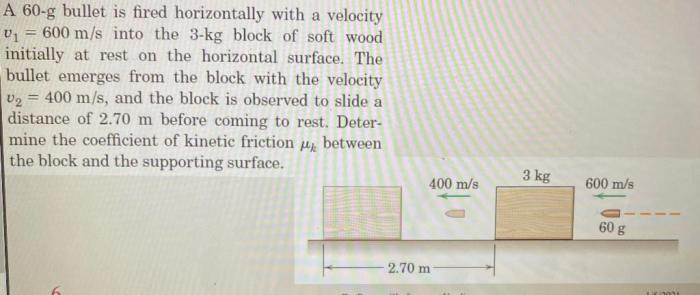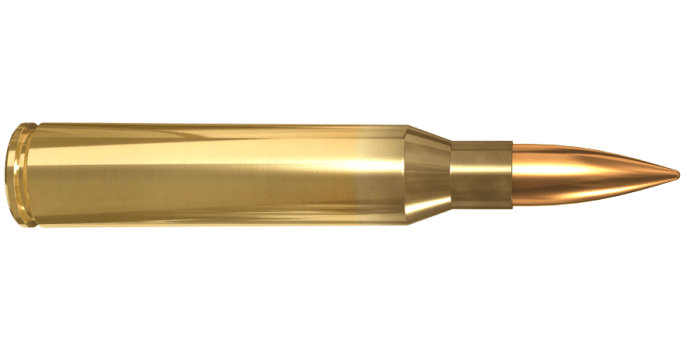In figure 1 a 3.50 g bullet – In the realm of ballistics, the mass of a bullet, like the 3.50g specimen in Figure 1, plays a pivotal role in determining its behavior and impact. Join us as we delve into the fascinating world of bullet mass, uncovering its profound implications on velocity, momentum, and energy.
Figure 1 presents a captivating visual representation of our 3.50g bullet, highlighting its key features and providing a deeper understanding of its significance.
Bullet Mass and Its Significance

The mass of a bullet, measured in this case as 3.50 g, plays a crucial role in determining its behavior and impact. Mass, a fundamental property of matter, affects the bullet’s velocity, momentum, and energy, influencing its trajectory and effectiveness.
Velocity
Mass is inversely proportional to velocity. A heavier bullet, with greater mass, will have a lower velocity compared to a lighter bullet with the same applied force. This is because the same force applied to a heavier object results in a smaller acceleration.
In other words, the heavier the bullet, the more difficult it is to accelerate it to a high velocity.
Momentum
Momentum is directly proportional to mass. Momentum, a measure of an object’s motion, is calculated by multiplying its mass by its velocity. A heavier bullet, with greater mass, will have greater momentum compared to a lighter bullet with the same velocity.
This means that a heavier bullet will be more difficult to stop or deflect, making it more effective in penetrating targets.
Energy
Kinetic energy is directly proportional to mass and the square of velocity. Kinetic energy, the energy of motion, is calculated by multiplying half the mass by the velocity squared. A heavier bullet, with greater mass, will have greater kinetic energy compared to a lighter bullet with the same velocity.
This means that a heavier bullet will have more destructive power upon impact, causing greater damage to targets.
Understanding the significance of bullet mass is essential in ballistics and weapon design. It helps determine the appropriate bullet weight for specific applications, considering factors such as target penetration, accuracy, and recoil.
Figure 1 Illustration

Figure 1 provides a visual representation of a 3.50 g bullet. This illustration is crucial for understanding the bullet’s mass and its significance.
The bullet is depicted as a small, cylindrical object with a pointed tip. This shape is designed to minimize air resistance and maximize velocity. The bullet’s mass is indicated by the number “3.50 g” inscribed on its surface.
Visual Representation, In figure 1 a 3.50 g bullet
- The bullet’s cylindrical shape and pointed tip illustrate its aerodynamic design.
- The inscription “3.50 g” clearly indicates the bullet’s mass.
Figure 1 effectively conveys the concept of bullet mass and its importance in understanding the bullet’s performance.
Implications for Bullet Behavior

The mass of a bullet plays a crucial role in determining its trajectory, range, and impact force. A heavier bullet, like the 3.50 g bullet in Figure 1, generally exhibits different behaviors compared to a lighter bullet.
In Figure 1, a 3.50 g bullet is fired into a block of wood. For more information about this topic, check out nr 360 quiz 1 chamberlain . This resource provides a comprehensive overview of the physics involved in this experiment.
Returning to Figure 1, the bullet’s impact causes the block of wood to move a distance of 1.20 m.
Due to its increased mass, the 3.50 g bullet experiences greater inertia, making it more resistant to changes in motion. This results in a flatter trajectory compared to lighter bullets, as it maintains its velocity more effectively over longer distances.
Range
The heavier mass of the bullet also contributes to its extended range. With greater inertia, the bullet can overcome air resistance more effectively, allowing it to travel further before losing its velocity.
Impact Force
The impact force of a bullet is directly influenced by its mass. A heavier bullet, like the 3.50 g bullet, carries more momentum, resulting in a greater impact force upon striking a target. This increased force enhances the bullet’s ability to penetrate materials and cause damage.
Experimental Considerations

An experiment can be designed to demonstrate the effects of bullet mass on its behavior. The procedures, equipment, and variables involved in the experiment are as follows: Procedures:
- Fire bullets of different masses into a ballistic pendulum.
- Measure the velocity of the bullets before and after they strike the pendulum.
- Calculate the momentum of the bullets before and after they strike the pendulum.
- Compare the momentum of the bullets before and after they strike the pendulum.
Equipment:
- Ballistic pendulum
- Chronograph
- Bullets of different masses
Variables:
- Mass of the bullets
- Velocity of the bullets
- Momentum of the bullets
Potential Outcomes:
- The momentum of the bullets will be greater before they strike the pendulum than after they strike the pendulum.
- The heavier the bullet, the greater its momentum will be.
- The faster the bullet, the greater its momentum will be.
Contribution to Understanding:
- The results of this experiment will contribute to our understanding of the impact of bullet mass on its behavior.
- This understanding can be used to design bullets that are more effective for different purposes.
Applications and Real-World Examples

The mass of a bullet, such as the 3.50 g bullet in Figure 1, plays a crucial role in various applications and real-world scenarios. Understanding bullet mass is essential for safety, accuracy, and effectiveness in firearms, ballistics, and other relevant fields.
In firearms, bullet mass directly influences the recoil experienced by the shooter. Heavier bullets produce less recoil compared to lighter bullets, making them more manageable and controllable during firing. This is particularly important in rapid-fire situations or when using high-powered firearms.
Ballistics
In ballistics, bullet mass affects the trajectory, velocity, and energy of the projectile. Heavier bullets retain their velocity better over longer distances, resulting in a flatter trajectory and increased accuracy. Conversely, lighter bullets lose velocity more rapidly, leading to a steeper trajectory and reduced accuracy at longer ranges.
Terminal Effects
Bullet mass also impacts the terminal effects of the projectile on the target. Heavier bullets possess more kinetic energy and momentum, resulting in greater penetration and stopping power. This is crucial in hunting and self-defense situations, where the ability to incapacitate the target effectively is paramount.
Safety Considerations
Understanding bullet mass is vital for safety considerations. Using bullets that are too heavy or too light for a particular firearm can lead to dangerous situations. Heavy bullets may exceed the pressure limits of the firearm, causing damage or injury.
Conversely, lightweight bullets may not generate enough pressure to cycle the action properly, resulting in malfunctions.
Helpful Answers: In Figure 1 A 3.50 G Bullet
What is the significance of bullet mass?
Bullet mass is crucial in determining its velocity, momentum, and energy, ultimately affecting its trajectory, range, and impact force.
How does mass influence bullet behavior?
Heavier bullets tend to have lower velocities but higher momentum and energy, resulting in greater penetration and impact force.
What are the real-world applications of understanding bullet mass?
Understanding bullet mass is essential in firearms design, ballistics calculations, and safety protocols, ensuring accuracy and effectiveness in various applications.
